JRCLS General Conference Reception
If you happen to live in Utah or will be traveling there for General Conference, you should consider attending the BYU Law School reception for alumni and J. Reuben Clark Law Society members. It is held at the Joseph Smith Memorial Building in Salt Lake City. I’ve always thought it would be nice to attend, but it’s probably not worth the 3,000-mile drive just to have lunch. If you are interested, today is the last day for registration.
Remains of abducted BYU student found
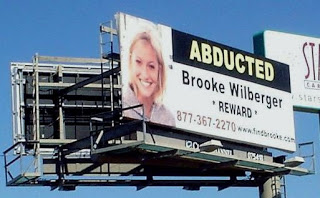
Authorities in Corvalis, Oregon, announced yesterday that they had found and identified the remains of Brooke Wilberger, a 19-year-old BYU student who disappeared in the Spring of 2004. At the time of her disappearance, Wilberger had been helping her sister clean the lamp posts of the apartment complex her sister and brother-in-law maintained near the Oregon State University campus.
The case was unusual in that a search commenced almost immediately. Law enforcement officials usually wait a few days before searching for a missing adult because adults have the autonomy to come and go as they please, but the Corvalis authorities agreed with family members that the straight-laced BYU coed was not the sort of young woman to disappear on her own. Despite the early and large-scale search and national headlines, Wilberger was not located no one reported having seen her.
Another unusual element of the case was the fact that Wilberger’s long-time boyfriend was immediately ruled out as a suspect. Significant others are frequently prime suspects in disappearance cases, but Wilberger’s boyfriend had an iron-clad alibi: he was in Venezuela serving as a Mormon missionary.
Eventually the investigation led to Joel Courtney, who was already doing 18 years in New Mexico for the kidnapping and rape of a college student in that state. Wilberger’s DNA and hairs were found in Courtney’s van, and Courtney was to go on trial in 2010 for the kidnapping and attempted rape and murder of two other Oregon State coeds, an incident that occurred on the same day Wilberger disappeared.
Yesterday Joel Courtney entered a guilty plea for the aggravated murder of Brooke Wilberger in order to avoid the death penalty. He received a life sentence without parole. As part of his plea, Courtney disclosed the location of Wilberger’s body, which police later confirmed. Courtney’s plea provides some closure to Wilberger’s family, who have waited more than five years to know what happened to their daughter.
Tithing and ill-gotten gains
Val Southwick, the CEO of VesCor who is in prison for swindling investors out of more than $180 million. The scheme took in many people in Utah, and many of the victims and at least some of the perpetrators are members of the Mormon Church. Last week the Salt Lake Tribune reported that Southwick had paid over $200,000 to the LDS Church in tithing, and that the LDS Church was now returning that money to be part of the restitution to the victims.
U.S. District Court filings show Val Southwick paid The Church of Jesus Christ of Latter-day Saints $202,761.74 between 2001 and 2006.
In 2008, the LDS Church Corporation of the Presidency agreed to return the money as part of a Securities and Exchange Commission enforcement action.
I don’t imagine $200,000 will go very far when the total amount stolen is more than $180,000 million, but it’s better than nothing. I note that $200,000 in 10% tithing would indicate an income of about $2 million over the course of seven years. It seems very unlikely that Southwick only kept $2 million of the $180 million for himself, so it sounds like he was lying to his church as well as his investors. What a guy.
The Salt Lake Tribune article noted that LDS Church spokesperson Scott Trotter says the LDS Church has a policy of not profiting from alleged ill-gotten gains. I find it interesting that the Church rejects donations derived from allegedly ill-gotten gains. To some degree this policy delegates authority to law enforcement officers and prosecutors. In this case, the initial determination of wrong-doing was made by a prosecutor or SEC officer, not the LDS Church. But the policy seems like a prudent one to me, both in terms of practicality and perception.
Looking to Catholicism to predict the future of Mormon church courts
Last week here was some speculation that former congressman Joseph Kennedy II might run for the Senate seat vacated by the death of his uncle, Ted Kennedy. Mitt Romney’s name was also tossed about, but both he and Joe Kennedy have stated they would not run for the seat. I looked up some information on Joe Kennedy and got sidetracked by an interesting quasi-legal proceeding in his past. Joe Kennedy asked the Boston Archdiocese to annul his first marriage with Sheila Brewster Rauch, but Rauch refused to agree to the annulment. The Boston Archdiocese eventually granted the annulment over Rauch’s objections, and she later appealed to the Vatican. The annulment was overturned in 2005 by the Roman Rota, the highest appellate tribunal of the Roman Catholic Church.
I was not familiar with the hierarchy of Roman Catholic tribunals, so this process was fascinating to me. Apparently there is a rehearing mechanism that is part of the Roman Rota, in which another panel of the Rota could hear the matter again (somewhat like an en banc rehearing). I thought it was interesting that Rauch, who is not Catholic, still had “standing,” for lack of a better word, to appeal the Boston Archdiocese’s decision.
The Mormon Church has its own system of church courts, mostly focused on the ward and stake level. My understanding is that an “appeal” from a stake disciplinary hearing goes straight to the First Presidency. I also believe that, in some situations, such as a temple divorce, a determination is made in conjunction with the First Presidency and local leaders. (Commenters with better information are welcome to clarify or correct me as to these policies.)
The Roman Catholic Church is a much larger worldwide denomination than the LDS Church. But despite the disparity in size, the two churches have much in common because they are both centrally operated. As the Mormon Church deals with the challenges of operating in many countries, I think it would be instructive to look to Catholic procedures to see how it handles similar challenges. With a membership of over 13 million, a surprisingly large number decisions in the Mormon Church are still made at the level of the First Presidency. However, as membership and population bases spread, I can imagine a time in which the First Presidency assigns some of these proceedings to a separate body. For example, a panel of members of the Quorum of the Twelve or the Presidency of the Seventy could be assigned to examine some appeals, much as the Roman Rota would hear an appeal from an archdiocese.
Obviously, this is pure speculation on my part. But in our lifetimes we have seen the Quorums of the Seventy expanded significantly, and the general trend in the LDS Church is to designate more autonomy away from the First Presidency and Quorum of the Twelve to the Seventies and Area Authorities. So some modifications to church court appellate procedures are certainly possible.
ABA Journal’s Top 100 Legal Blawgs
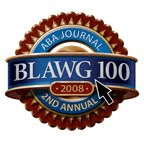
The ABA Journal is looking for suggestions of the best legal Blawgs in the country to include in it’s annual ‘100 Best Legal Blawgs’. Click HERE to submit your favorite blawg to the ABA Journal. I submited the Volokh Conspiracy even though I think it’s the second best Blawg in the country.
Judge J. Clifford Wallace, Jurist Without Borders
This past month California Lawyer Magazine featured LDS Judge J. Clifford Wallace. He is a senior Judge on the Ninth U.S. Circuit Court of Appeals, who has been serving on the bench since President Nixon appointed him in 1972.
Wallace “has traveled to some 60 countries, advising judiciaries on everything from combating corruption to implementing mediation programs to staving off interference by a military president. His pioneering work in the international rule of law movement predates the American Bar Association’s initiative in Eastern Europe by 20 years.
The silver-haired judge, who turned 80 last December, is revered as one of the world’s leading experts on judicial administration. In Thailand, Wallace is referred to as “father of the courts.” The chief justice of Guam considers himself “blessed” to have Wallace’s guidance.
Wallace enjoys a following in the United States as well, at least among conservatives… he has taken stands in his legal writings against affirmative action, abortion rights, and physician-assisted suicide. According to a 2006 study, Wallace was the least likely of the circuit’s judges to grant asylum, voting in favor of asylum seekers only 4 percent of the time. A frequent speaker for chapters of the Federalist Society and the American Enterprise Institute, on more than one occasion he was considered for a seat on the U.S. Supreme Court. In 2005 he received the Edward J. Devitt Distinguished Service to Justice Award—the most prestigious honor in the federal judiciary—and more than 60 of his former clerks turned out for the presentation.
The amount of good that the Honorable Judge Wallace has done throughout the world is amazing. He’s an inspiration we can all look to.
Where to sit in the library?
It may sound like a simple question but sitting in the right spot in the library can be the difference between having a good study session or just wasting time. Because each spot in the library is different you don’t want to sit in the wrong spot. There’s the parts of the library that are always hot, there’s the areas that are too cold, some areas have terrible lighting, some areas are louder than BYU football games, and some areas are so remote I don’t like sitting in them because I feel like I might run across a homeless person who decide to make that quite part of the library their home.
For those of you who don’t know what I’m talking about, sitting in the wrong spot in the library is similar to when you’re standing in the candy isle trying to decide what candy bar you want. After ten minutes of contemplation you narrow your choice it down between a Snickers and Twix. You decide to go with a Snickers but as soon as you take the first bite you realize you should have gone with a Twix or maybe a Heath Bar. Similarly when you sit in the wrong spot you just know it, don’t fight the urge just pack up your stuff and move to the “right spot” so you can get some good studying in.
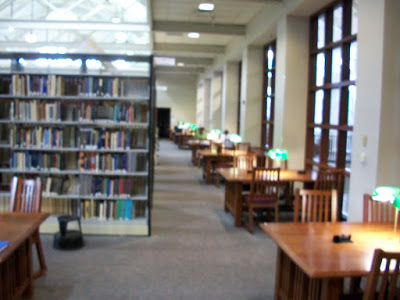
Above is where I like to sit when I know that I’m going to be getting phone calls. There’s a door at the far end of the tables that leads out onto a “cat walk” where you can talk freely. I don’t want to be that guy who screams into the phone, “hello? Yeah, I can talk I’m just in the library”.
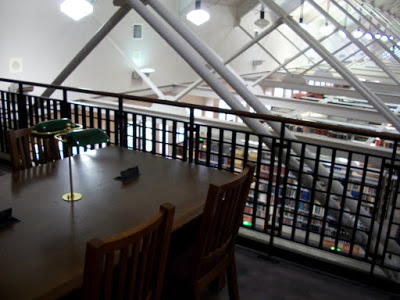
This is what I call the “Penthouse Level” the view is great but I’m too lazy to walk the four flights of stairs to get up to it.
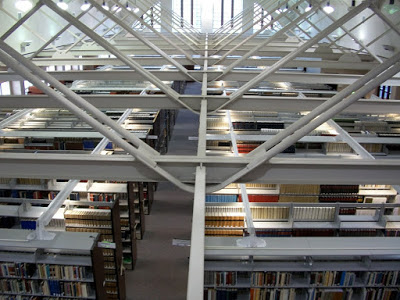
Here’s one view from the “Penthouse Floor”
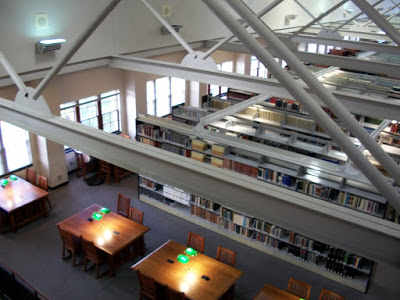
Here’s another view from the “Penthouse Floor”
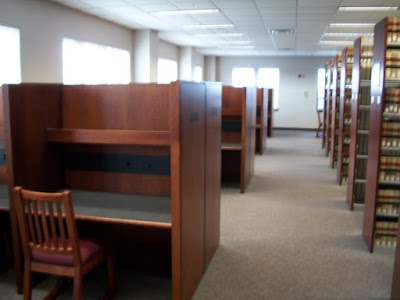
I sit in these cubicles during finals when I don’t walk to talk to anyone and I really need to get quality studying time in.
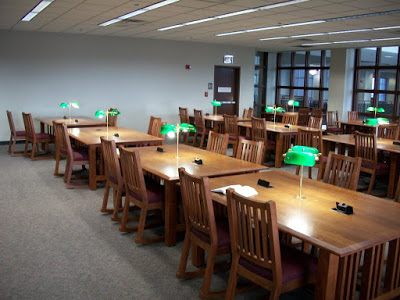
I sat at the far table in the nearby row everyday for 3 semesters. Even though I think this is the best room in the library I don’t study in here anymore because it reminds me of long stressful days. It’s like when you eat so much of your favorite food that you just don’t like it anymore.
So the next time you’re thinking about where you should sit in the library or what candy bar to eat make the right decision or else you’ll regret it.